 Wouldn’t life be easier if people opened and read your fundraising emails?
Wouldn’t life be easier if people opened and read your fundraising emails?
And even better, RESPONDED to them by clicking the Donate Now button?
It’s frustrating to spend precious time and effort drafting a request for support only to hear crickets.
Maybe you check your open rate and see that only 25% of your audience bothered to open the email you spent hours writing. (That’s average.)
Ugh. So frustrating!
But look: even if your open rate is only 25%, you are connecting with one quarter of your email list, and that’s significant.
When you post on social media, you don’t know how many people actually see your content. It’s definitely not as many as we would like.
And when you post on your website, well, most of your donors aren’t regularly visiting your website.
Still, we all want better open rates.
So, what can you do to get more people to open and respond to your fundraising emails?
What You Need to Know About Open Rates
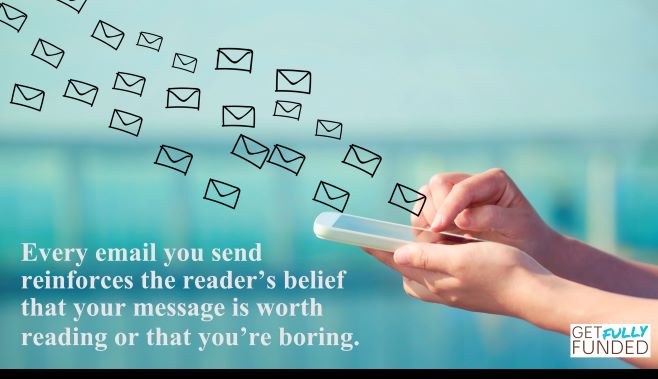 I can tell you why your open rates aren’t higher, and it’s not just because people are busy.
I can tell you why your open rates aren’t higher, and it’s not just because people are busy.
We have trained our supporters to ignore us.
We send boring email after boring email, and our readers decide there can’t possibly be anything worth reading in the next message, so they don’t bother.
We’ve conditioned our readers to expect junk from us by sending junk over and over.
Think about it: If you receive three or four emails in a row from a nonprofit you support, a blogger you follow, or your favorite store and the content is boring or useless to you, how long before you stop opening them?
That’s what I thought.
We don’t have time or patience to tolerate boring messages. We simply delete and move on to something more interesting or more pressing.
If you’re using email as a fundraising and donor communications tool, you can’t afford to send anything dull. You need that open rate to be as high as possible, and you need donors to be moved to give.
So, how do you show up as interesting and relevant in your donors’ inbox time after time, so they click on your emails, read them, and donate?
Well, it’s tricky.
Success in email requires copywriting skills, which you can learn.
Success also requires taking the time to get the message just right. Unfortunately, writing a marketing or fundraising email is often a task left until the last minute and rushed through to check off the to-do list.
I get it.
We’re all busy and most people don’t like writing.
That was me back in the beginning.
When I first started in fundraising, I didn’t know anything about stringing words together to motivate someone to give.
You know how I got to be a better writer?
I wrote.
The more I wrote, the more I improved.
Writing marketing copy is a skill. And, now, years later, I can get the results I’m looking for with an appeal or a fundraising email, because I developed the skill through practice.
How did I learn? I took copywriting classes. I worked to develop my own voice. And I studied appeals that impressed me.
Over the years, I learned some tricks that made my copy strong and effective.
And those tricks are what I’m sharing with you today.
Better Fundraising Email Trick #1: Write to One Person
Your donor is an individual person.
He or she will personally read your fundraising email.
So write to your donor as an individual person.
If you write to your audience, using phrases like as you all know and I hope everyone understands, it makes the reader feel like one among many.
And that does NOT inspire people to give.
People don’t want to feel like one of the crowd. They want to feel like they matter to you.
When they’re one of many, they don’t feel special. They don’t feel like it’s important that they take action. They aren’t motivated to give. They’re just one of potentially hundreds or thousands of people you are writing to.
How do you make sure your donor feels like you are writing just to them? Try my kitchen table exercise.
Imagine your donor sitting across your kitchen table from you. You’re having a cup of coffee talking about the ways your nonprofit changes lives. What would you say? What stories would you tell? How would you ask for a donation?
Write that!
Write like you are having a conversation with a donor at your kitchen table. You can practice on friends and family members. See what resonates with them, what they respond to, what makes them feel like your organization is the right one for them to support.
When you edit your email copy, ask yourself, “Would I say this to a donor sitting at my kitchen table?” At first, the answer will probably be no. We tend to write in a stiff, formal style when we are in the role of representing our nonprofit.
Look, stiff and formal does not fly in marketing or fundraising! Stiff and formal does not motivate people to read emails and respond with a gift.
If you approach your writing with a kitchen-table mindset, your fundraising emails will be more personal and help you make a connection with your reader.
Better Fundraising Email Trick #2: Keep It Conversational

As you think about writing to just one person instead of your whole audience, think of that person as a friend, not a donor.
And think of yourself as having a conversation with your friend about what’s going on with your nonprofit.
The mortal enemy of a conversational writing style is jargon.
The nonprofit sector is full of jargon, so it’s tempting to include it in your emails: acronyms, slang, politically-correct verbiage, and on and on it goes.
Go through your draft email and replace any jargon with conversational words. If you can’t think of a conversational word to use, rework the sentence. Remember, you don’t want to send boring emails!
Hold the acronyms. To readers, they can be confusing. Like jargon, acronyms tend to stop readers in their tracks and motivate them to stop reading, close the email, and do something else. Spell out the acronym you are trying to use unless you are positive your readers will know exactly what you are talking about without having to think about it.
Stop trying to sound smart when you write fundraising emails. Your readers do not need you to be smart. They need you to tell them a story that interests them and moves them. They would love for you to surprise and delight them.
When you try too hard to sound smart, you sound inaccessible and inauthentic. Think about having a conversation with a friend and just sounding like you. Your readers will be more likely to listen.
Better Fundraising Email Trick #3: Write in Small Bites
The five paragraph essay you learned to write in school is not what you want for your fundraising email.
Instead think short paragraphs, short sentences, and short words.
Because shorter is easier to read.
Paragraphs should be two to three sentences and no more. Sentences should be 20-ish words or less.
Less is definitely more!
No one wants to read a long paragraph full of dense text and too many words. That kind of reading can feel like a chore, especially if you are reading on your phone screen, which most of your readers probably are.
If you catch yourself writing a compound-complex sentence, break it up.
If your paragraphs are long, cut some of the text out.
Seriously.
Accept that people have short attention spans these days. You will have a better chance of hooking the reader if you don’t expect them to work too hard.
Writing in small bites can truly transform your writing. You will discover when you start breaking up paragraphs that you can just delete entire sentences without losing any of the meaning. When you start breaking up sentences, you will realize entire phrases can just be deleted. So much of what we write is redundant, not interesting, and unnecessary.
When I write my first draft, I go wordy, typing everything that comes to mind. Then I chisel away at my draft, leaving only the words and sentences that are necessary to say what I want to say. Then I read it to myself, out loud if possible.
Do I sound like I am chatting with a friend at my kitchen table? If so, I have done my job and can move on.
If not…well, there’s more work to do on it before it’s ready to send out.
Better Fundraising Email Trick #4: Nail Your Subject Line

How do you decide whether to open an email?
You look for clues.
You probably first look at who it’s from. Do you know and trust that person? Do you want to find out what they want?
Next, you read the subject line.
If it’s interesting, you’ll probably open the email. If not, you won’t.
A subject line has ONE job – to get the email opened.
Given that the goal here is to get your donor to open the email, read it, and donate, you really need your subject line to do its job.
Yet, people often slap a subject line on their email at the last minute and without much thought. This is such a missed opportunity!
Instead of writing the first subject line that pops into your head, write 10 possible subject lines and pick the best one.
And write the subject line after you write your email. Right after. Don’t close the computer and come back to the task. Brainstorm 10 subject lines while your email content is fresh in your mind.
What works in a subject line? Asking a question. Challenging the reader’s thinking. Stating something controversial or counter-intuitive.
Try using the reader’s name in the subject line, using a merge field.
Jasmine, do you want to be a hero today?
Keith, do you need a dose of happy today?
Hannah, can you predict the future?
Isaac, I just have to share this story…
Taylor, this is too cool not to share!
Alex, March was the month when nothing went according to plan
Maria, I have to introduce you to my friend, James
Hey Chloe, here’s one simple way for you to make a difference today
David, I have unexpected news to share
Angela, wait until you meet Chowder … Guaranteed to steal your heart
Brittney, do you want to save a kitten today?
Make your subject line long enough to pique the reader’s interest and short enough to read on a mobile device. Mail Chimp gives you immediate feedback on your subject line’s length.
Don’t try to summarize your email message in the subject line. That is not what the subject line is for. Use the subject line to entice the reader to open the email.
Want more samples? Here are 100 fundraising email subject lines that will get donors to open your email.
Better Fundraising Email Trick #5: Focus on ONE Thing
Too many fundraising emails have an everything-but-the-kitchen-sink feel. Especially newsletters.
They just go on and on with one news item after the next, each one less interesting than the one before.
You want your donors to give? Focus on ONE thing and one thing only.
There’s a saying that a confused mind always says “no.” If you cram too many things into an email, there’s too much for a reader to try to soak up.
And if there are multiple calls to action, you’ve lost them. More than likely, they’ll take the path of least resistance and do the thing that seems easiest, which may or may not be the thing you really want them to do.
So, keep it simple. Stay focused on one thing. Don’t ask for a donation, issue a call for volunteers, and remind people about your wish list.
Leave those bits and other news for social media posts, your blog, or your newsletter.
Here’s a template for writing a fundraising email that will keep you focused on your purpose.
Sample email
Let’s look at an example of a fundraising email done well.
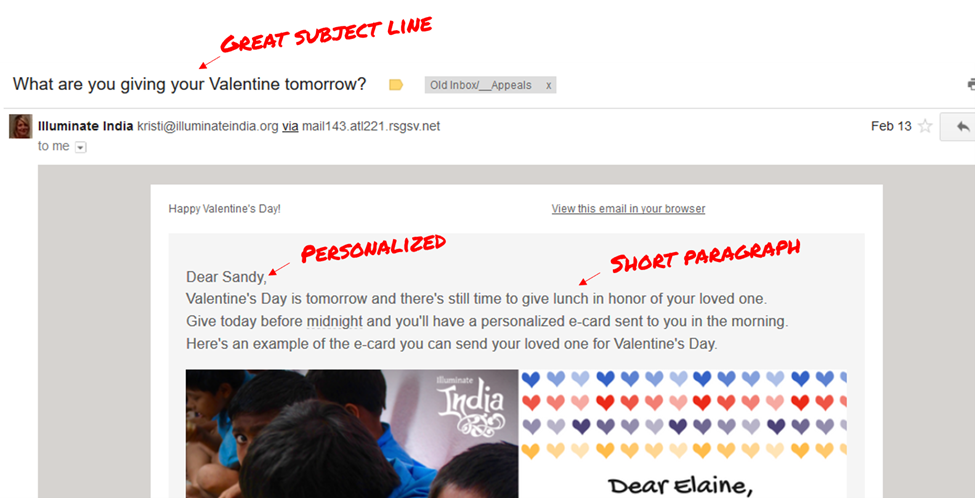
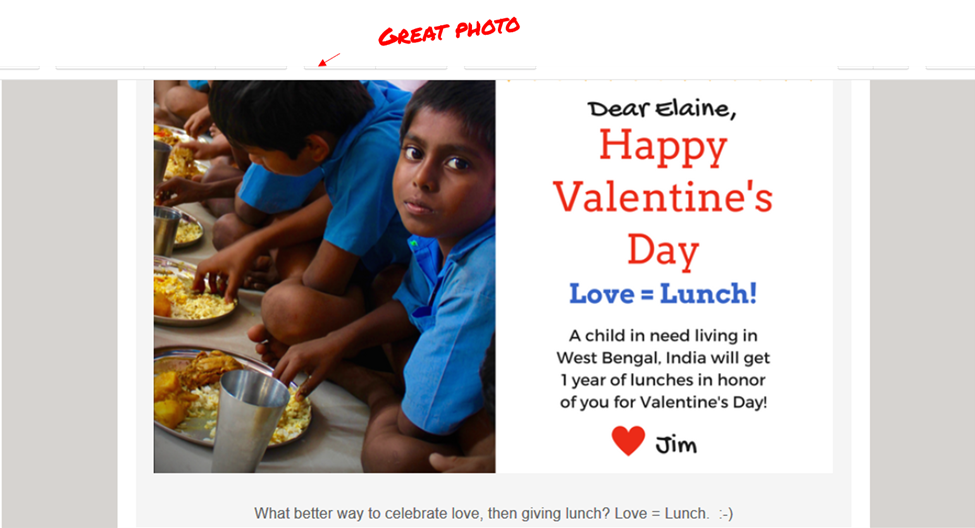
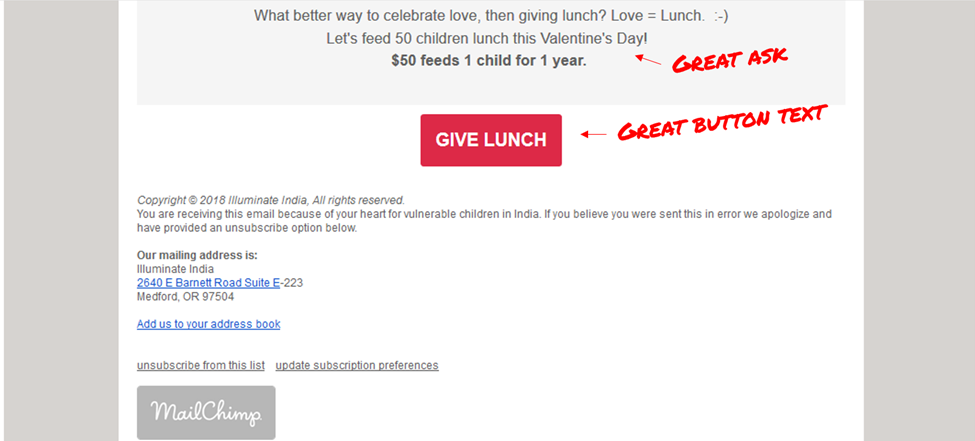
It’s a short, sweet email that’s engaging. It gets right to the point, includes personalization and a heart-warming photo.
This kind of fundraising email clearly shows donors the need and the action they need to take.
And, it will leave readers looking forward to the next one.
The Bottom Line
Taking the time to learn to write more effective fundraising emails is time well spent.
Email is an important tool for communicating with donors and an important part of your annual fundraising plan. If you don’t write the best emails possible, you’re leaving money on the table.
The only real secret to getting donors to read your emails is to write emails they want to read. When you capture their attention with a subject line and then touch their heart with a moving story told in a conversational tone, donors will read and respond.
If you consistently send interesting emails, donors may do more than just open them. They may even look forward to receiving them.

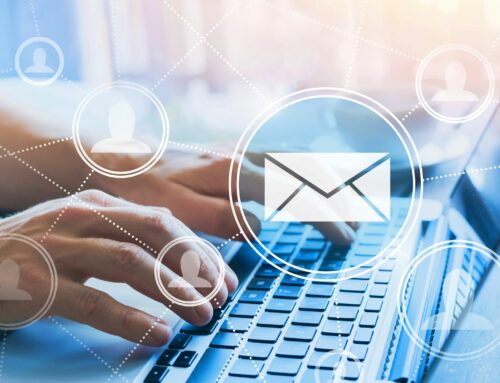




Leave A Comment